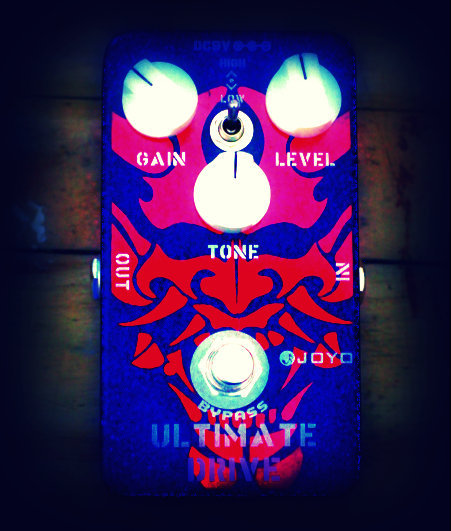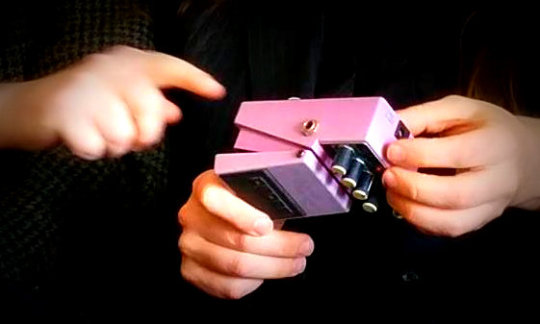Text
Adrian’s Mods - The Joyo Ultimate Drive
Our latest pedal comes from Adrian, and although its not old it still has a tale to tell. It’s interesting how things get modded, adapted and there endless ways that you can engage in making and modding pedals sound like “this and that”.
Adrian says “ I have passed on my ‘modded’ Joyo Ultimate Drive pedal. This is not an old pedal with a rich history, but it does have its own story and one that highlights the world of guitar pedals and the mind of the electric guitarist.”
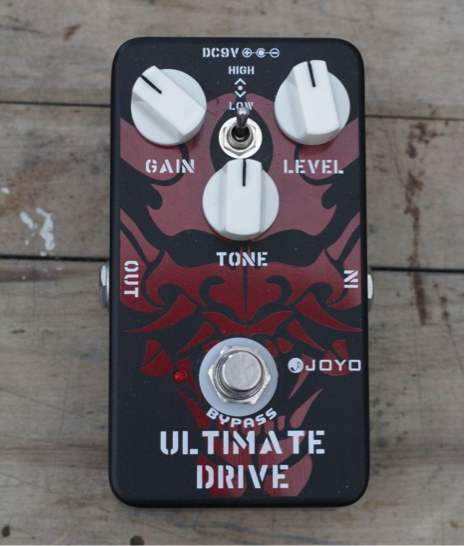
First a bit of background …
I used to play the guitar a lot in earlier years but for a number of reasons too boring or inconsequential to outline here I took an extended hiatus from playing about 15 years ago. In recent years a growing desire to spend time playing again has resurfaced and I feel refreshed and eager, albeit extremely rusty. Alongside there is also a renewed desire to buy loads of new gear! At around the time I stopped playing most of my stomp boxes were stolen … well, I say stolen, the truth of the matter being that at the end of a rehearsal I drove off into the sunset leaving a large holdall with my pedals, leads and assorted items on the pavement. However, at the time I was living the 80’s / 90’s guitarist dream, so my main set up consisted of a rack mounted preamp and power amp with midi controlled digital multi-effect processors and a two speaker cabinets for those glorious stereo chorus and delay patches … yes, I was that cool. I discovered that this equipment has not aged well over the years, both in terms of its sound and reliability. The latter was revealed when I dragged my flightcase of gear out of the garage, brushed off the dust, plugged it in, powered it up and lo and behold I wasn’t greeted with a squealing fanfare of joy, but rather silence. Thus, it became clear that I would need to start scratch. But this is not a sad story, on the contrary, the life of the electric guitarist revolves around three main activities that each vie for prominence: playing the guitar, buying guitar related equipment and thinking about buying guitar related equipment. So, I’ve gladly embraced this period of discovery and research; pouring through YouTube videos of demos of this amp, that guitar, this pedal and that pedal, convincing myself at each turn this is what I need to get the holy grail of tone.
Electric guitar equipment is steeped in the folklore of those heady days of the 50’s, 60’s and 70’s when guitars, amplifiers and pedals were (apparently) made properly. The standards were set during these times, such as the sound of a Fender Stratocaster plugged into a Deluxe Reverb or a Gibson Les Paul into a flat out Marshall Plexi. These objects have defined the archetypical ‘tones’ as captured on our favourite records by our favourite players. Accordingly, guitarists on the whole do not look forward, but rather we look back to these glory days and we strive to attain these classic artefacts and their benchmark tones … or more practically speaking, we strive for something cheaper that sounds the same! (note: these ‘cheaper’ alternatives nonetheless need to demonstrate lineage to these classic designs … “Oh yeah, my [insert choice of amplifier manufacture here] uses the same NOS valves and orange drop capacitors as the original Vox AC30” or “My [insert stompbox drive pedal of choice here] uses the same JRC4558D chip as the original Tube Screamer” etc, etc).
A guitarist’s sound is a very particular business. This retrospective view on what electric guitar tones should be place manufacturers in a difficult spot, which can be seen by a survey of their product descriptions. On the one hand R&D time and resources are spent trying to carve out space in the market for new products, but on the other hand these new products are largely required to deliver what we expect, namely the old established tones. So, the same designs and circuits are revisited time and time again, being ever so slightly iterated to permit lofty claims of an improvement to the old one.
But, what does this have to do with my Joyo Ultimate Drive pedal? Well, my journey for a new setup started with many hours spent researching pedal products. I discovered that in recent years there has been a renaissance in effect pedals, there’s a crowded marketplace of bespoke pedal manufacturers offering a range of wares, the majority being individual recipes on the established circuits. Being a cheapskate, I then discovered the DIY end of the market, where you can buy an exact ‘clone’ of your favourite pedal in kit form to be assembled by yourself for a fraction of the cost of the real thing. One such product caught my eye, a kit clone of the Hermida Audio Zen Drive, a popular pedal that claims to mimic the overdriven sound of the highly revered Dumble Overdrive Special Amplifier. Apparently only 300 or so hand made Dumble amps were built. As legend has it one did not simply go and buy a Dumble Amplifier, but rather Mr Dumble decided if you were worthy to own one of his amplifiers. For many years the inner workings of these amplifiers were clouded in mystery as Mr Dumble worked hard to protect his design from being copied. He would cover his circuit boards in ‘goop’ (epoxy resin) to hide the components and circuit from being analysed. Furthermore, if you were one of the lucky ones who were allowed to buy one of his amplifiers (they tended to be high profile players such as Larry Carlton, Robben Ford, Stevie Ray Vaughan, Carlos Santana et al.) you had to sign a contract agreeing not to reveal any details about the amplifier. The following quote from the contract shows the degree Mr Dumble went to hide his work:
“I promise to never allow the equipment to be opened, analized, and/or inspected by any individual, group of individuals, and/or commercial entity other than H. Alexander Dumble. I also agree and promise that I will always maintain the strict supervision over the equipment; and to never leave it vulnerable to theft and/or inspection/analization by any individual, group of individuals, and/or commercial entity. I further agree and promise that I will not sell the equipment built for me by H. Alexander Dumble to any individual, group of individuals, and/or commercial entity that will invade and/or compromise the secrecy of H. Alexander Dumble's circuitry and techniques used in the manufacturing of his equipment”
Needless to say that over the years Dumble amps were indeed sold on, de-gooped, analysed, cloned and copied and now a wide range of bespoke amplifier manufacturers sell their exact replica or iteration of the Dumble amp to eager players (e.g. Two Rock, Fuchs, Ceriatone, Carol Ann, Bludotone). Original Dumble’s are highly sought after and owners demand exorbitant prices for them; they are the worlds most expensive amplifiers, as this current advert contends, a mere £96,413.31. Back to the story … So, my thought process was a follows: buy a DIY pedal kit for £16.79 that I have been assured will sound just like a real Zen Drive pedal (retails at £185) that I have been assured will sound just like a Dumble Overdrive Special Amplifier (£96,413.31 second hand). This sounded like a reasonable proposition to me, so I placed my order and received my Zen Drive kit a week later. I then discovered that my soldering ‘chops’ were as rusty as my guitar ‘chops’, further hampered by a soldering iron whose tip had all the precision of a butter knife. So, unfortunately the kit suffered “manufacturing issues” and my quest for the Dumble tone stalled.
I returned to my pedal research to discover a number of companies selling pre-manufactured ‘working’ clones of your favourite pedal for a fraction of the price of the original. These pedals obviously are bestowed with different names and designs than the original, but it doesn’t take much digging to reveal the copied pedal. Apparently circuit board designs are not protected by intellectual copyright (unqualified statement alert!). One such clone that received great reviews across the web was the Joyo Ultimate Drive, a clone of the well-liked Fulltone OCD overdrive and distortion pedal, a bargain at £31.03 (Incidentally, it is claimed that the Fulltone OCD pedal is essentially a copy of the RAT Distortion pedal).
I took the plunge and bought the Joyo without hearing one in the flesh or the real Fulltone OCD for that matter. On receipt of the Joyo my impressions of the pedal were largely of disappointment, it’s not that it sounded bad, but it was not really what I was after.
I continued to read up online about the Joyo Ultimate Drive pedal and came across this interesting story. It appears that a certain boutique pedal manufacturer was (allegedly) caught bulk buying the Joyo Ultimate Drive pedal, changing three of the components (swapping a capacitor for a different value and adding resistors to the gain and tone potentiometers), gooping the circuit board to cover the ‘Joyo Ultimate Drive’ text printed on the board and re-housing them in new case - Alpha Drive re-branding of Joyo Ultimate Drive.
They were then sold on at a ‘boutique’ price and marketed as a pedal that re-creates the sound of a Dumble amp! Putting the ethics of this aside, what peaked my interest was that this exposé meant his minor modifications were charted across various online guitar forums. So, having bought a new soldering iron I set to work to undertake the same ‘mods’ to my Joyo. This proved to be a more successful process than my previous effort and the sound of the pedal was indeed changed and greatly improved to my ears. Whether it sounds a like a Dumble amp or not I have no idea, never having played one, nor do I suddenly sound like Robben Ford or Stevie Ray Vaughan! The latter I have yet to figure out why…?
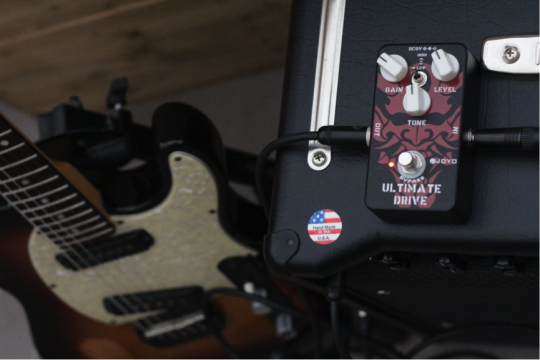
I have since moved on from my initial exposition into buying ‘something’s for nothing’ bathed in snake oil. I now own a number of other (non clone) pedals that better suit my taste and I find my Joyo Ultimate Drive taking a back seat on my pedal board. It seems appropriate that this pedal – a copy of a Fulltone OCD, which is a copy of a RAT Distortion that has been then modified to be a copy of a Dumble amp etc – should be transformed once more in the hands of a new player.
0 notes
Photo

John Harvey’s Diary
I often read John’s diary pages, it’s interesting to see what John’s up to - there’s always something different and he keeps a record or his thoughts and practice. There aren’t that many sound art people in the area, and he’s always got something to say, so I was quite surprised to see that John had mentioned the project.
I don’t want to say too much as I’m hoping to catch-up with John early in the Summer and see if he’s got anything that he’d like to add to the project. In the meantime have a read of John’s diary.
http://johnharvey.org.uk/index.php/may-24-2017/
Sorry for altering the colours of your page John, I thought this looked better on the page :)
0 notes
Photo

Mads and the Boss T-Wah - all the way from Copenhagen
8 notes
·
View notes
Text
Mads - Mr T-Wah
I’ve worked with Mads on a couple of things and he was one of the first people that I discussed this project with, and possibly the first to offer something to the project. The mighty Boss T-Wah TW-1. I liked the way that he called it a “studio relic”, added something to the meaning of the pedal, it’s almost as though part of that studio has been sent over - representing a time and place - there’s something of an architectural feel to the pedal. More about the project
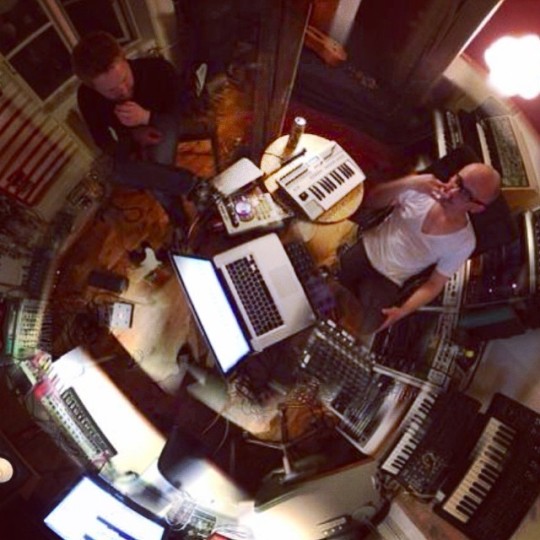
Studio-Scape (Mads right) from https://www.facebook.com/skyphonemusic/
Mads writes - The Boss T Wah has been lying around in our studio for as long as we can remember. The last couple of years we have changed studio quite a lot, but we have always kept it with us. No one notices it. If there are people coming to the studio, no one has gone “Oh, wow, you’ve a 1983 T Wah”.
But it’s like getting rid of it would just be too much – keeping odd pieces of gear maybe give you some stability, even if things around you change. No one really remembers who brought it in, and no one has used it for decades. It’s one very unloved piece of gear. The T Wah is like an envelope filter, meaning that the filter reacts to the sound coming into it and not to some user input like on a regular wah-wah pedal. However, most guitar players, I think, like the control of a wah-pedal, the idea that you shape the sound with your foot pedaling away on the Cry Baby wah, Jimi Hendrix style.

In the Studio with Skyphone
I think the pedal might be useful (and maybe even coveted) if you’re really into the ‘Funkadelic’, P-Funk genre-conscious wagga-wagga, chunking, but we’re into ambient, so it’s a bit tricky. I guess it could be used for some funk bass too, but the low end oomph of the bass is often lost with these kinds of filters. Maybe if we put a lot of reverb on it and played reeeaaaalllllyyyy sllllooooowwww.
Still, it’s kind of comforting to have it. To know that just in case, if you really wanted to and if you got this crazy idea of plugging a microphone or a marimba or a square wave generator into it, you could, and maybe you’d get something pretty amazing.
youtube
https://www.facebook.com/vuptikunst/
To learn more about the project look at the About Page
0 notes
Text
Dafydd - the Boss HF2
This is the first bit of kit that has been given to the project from Dafydd. I’d been discussing the project for a little while and he mentioned that he had an old flanger pedal. I met him at the National Library of Wales to pick up the old pedal in all of its dusty washed out lilac glory, and we talked about tape exchanges, places and PO boxes - an analogue world, pre-mp3. Diolch Dafydd! More about the project.

Daf and Me - Discussing the finer points of old pedals
Dafydd writes - This is a blurry photo of my Boss HF2 flanger pedal (below). I bought this years ago when Ruth and I lived in a chalet in Ciliau Aeron. This was the base from which we started recording and releasing tracks, on a Fostex 28H fourtrack, sending off to Crohinga's Well, Music and Elsewhere, The Organ, Better Days Distribution, Ptolemaic Terrascope, Magical Jack, Acid Tapes and many other places that seemed to thrive then, all pre-internet. A great time, picking-up post from Post Box 22 in Lampeter, trading with Sullivan Kenyata and sending tapes out for plays by Brian Turner at WFMU.
At Lampeter, through the good office of Phil McMullen we hooked up with an enthusiastic American gentleman who ran an HG Wells/Kurt Vonnegut inspired label, Spiffing Records This was Carl Arnheiter and he was kind enough to release part of our Echoing Grove as a 7"ep. Carl rang me up while Iwas in the department, it was weird, no mobile phone then no internet really and a strange gentleman from America wishes to speak to you...This was good and what was to be even better was inclusion, at still some time off later, in the mighty Ptolemaic Terrascope. I still remember very fondly the first issues of the Terrascope we got, fliers etc spilling out onto my lap, the anonymous black vinyly ep with USA Kaleidoscope, I am a hog for you baby on one side and The Wall of Sleep on the other. Features on Martin Carthy and a gamut of psychedelia and folk in the thick inky paper. Terrascope reinforced the musical tastes we had been developing and more crucially informed and broadened it into new trajectories, always managed through enthusiasm and great writing and humour, occasional letters form Phil McMullen were always a pleasure and a sustainer in those sometimes dark times of PhD-ness. So we always aspired to be in there somehow.
The flanger was bought, pretty much on a whim, having devoured that month's copy of Guitarist, it was probably the only thing I could afford and would doubtless revolutionise 'my sound'. As it happened, although I played a couple of songs to death on it, there was only one outing for this pedal. It contributed - I think - to some of the shimmering sounds in the background or maybe also on the only used once finger cymbals, this was on a scrap of tape for an untitled song, no words but worth keeping I thought.
I kept all the tapes then, stacks of I got an urgent message from Carl that there was going to be another Terrascope compliation CD and we should find somehting to submit. Even then, I realise now that even then I was slow to get things done - so the cupboard was bare, until I remembered the scrap that was given a very gransiose title in honor of the magazine, Terra Adamica. And what blew me away was that eventually when it was taken up for inclusion on one of their free cds - I have two copies at home in the archive - the mighty Nick Saloman - the actual Bevis Frond - rang me up to talk about being included on the compilation. I was gob smacked and generally unintelligent but it was a thill to be inlcuded and talked to by such heros and inspirers.
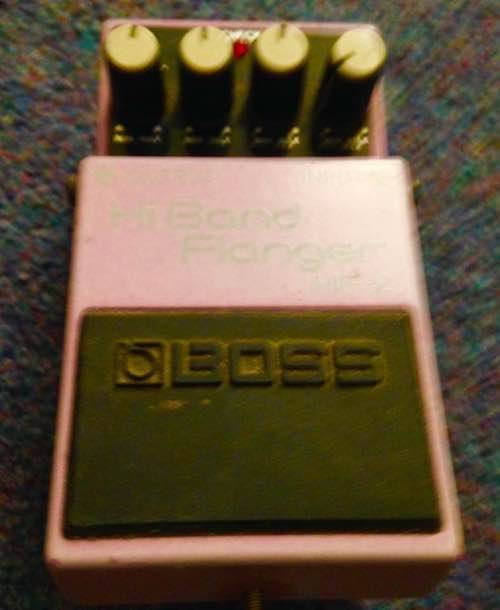
The Blurry Photo
This seems a long time ago now, another life. Still in the wilds of Ceredigion but no longer down the dank verdant lanes at Ciliau. So I associate the pedal with a particualr place and time and a particular track. But the pedal never had much of a life after that. I dont know why. And I half regret letting this pedal go to Alan, but let's see where his project leads. And I am still working on the proper follow up, it seems impossible to capture or recreate that time. Stumbling block.
To hear some of Dafydd’s music check out The Echoing Grove by Alphane Moon
And for more info have a look at Discogs:
Alphane Moon
Our Glassie Azoth
To learn more about the project look at the About Page
0 notes
